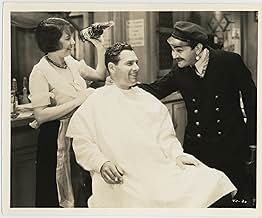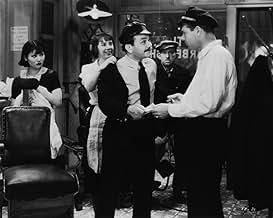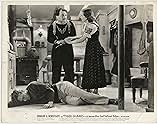IMDb RATING
6.3/10
1.2K
YOUR RATING
A tuna fisherman marries a woman who doesn't love him.A tuna fisherman marries a woman who doesn't love him.A tuna fisherman marries a woman who doesn't love him.
- Awards
- 2 wins total
J. Carrol Naish
- Tony
- (as J. Carroll Naish)
Sheila Bromley
- 'Red'
- (uncredited)
Wong Chung
- Chinese Laundryman
- (uncredited)
Edwin Maxwell
- Doctor
- (uncredited)
Toshia Mori
- Oriental Lady Barber
- (uncredited)
Henry Otho
- Crewman
- (uncredited)
Inez Palange
- Mike's Neighbor
- (uncredited)
Pedro Regas
- Crewman
- (uncredited)
Joe Roig
- Undetermined Secondary Role
- (uncredited)
Hector V. Sarno
- Crewman
- (uncredited)
Harry Semels
- Crewman
- (uncredited)
Featured reviews
Portuguese fisherman (Edward G. Robinson) loses a hand to a shark and later loses his young wife (Zita Johann) to his best friend (Richard Arlen). He doesn't like it. A simple plot that was reused by Warner Bros. many times over the years. It's an okay early film from Howard Hawks. Worth watching for Robinson's colorful performance. Eddie G's sporting an earring and a hook for a hand, folks. It's not Shakespeare but it's hard to look away. Real maritime footage is a plus. Classic horror fans will recognize Zita Johann from The Mummy, which was released this same year. She's a lot more subtle in this than in that film.
Exciting film about a love triangle on the Monterey coast with Edward G. Robinson and Richard Arlen best friends and tuna fishermen. Robinson falls for bad girl Zita Johann who of course falls for handsome Arlen. Familiar storyline but Robinson is excellent as the Portuguese fisherman who battles the sea and the sharks to make a living. Arlen was a so-so actor but very handsome, and Johann had a strange exotic look. She's best remembered for The Mummy with Boris Karloff. Vince Barnett is funny and J. Carroll Naish has one scene. Leila Bennett plays a barber for some reason with pretty Toshio Mori as her assistant. Inez Palange plays a neighbor. Good film all around. But the highpoint is the truly remarkable footage of tuna fishing in a stormy sea.
Edward G. Robinson plays a one handed fisherman making his living on the California coast. Even with a hook for a left hand he does pretty good in his line of work. But that steel hook isn't exactly quail bait.
One of his crew is lost to the sharks during a voyage and he brings the news home to his daughter Zita Johann. She's back home after having run away from the fishing life and has had a pretty rough go of it.
Though she doesn't love him, Johann marries Robinson and then another Robinson's crew, Richard Arlen comes in to complicate things.
Other reviewers have mentioned the gazillion times Warner Brothers recycled the plot of Tiger Shark in other locales. But actually Robinson had done a version of They Knew What They Wanted back in 1930 entitled A Lady to Love. That's the real origin of this plot.
The fishing boat scenes are realistically handled and the principal players do a good job. But this story has been told better and told better by Mr. Robinson himself.
One of his crew is lost to the sharks during a voyage and he brings the news home to his daughter Zita Johann. She's back home after having run away from the fishing life and has had a pretty rough go of it.
Though she doesn't love him, Johann marries Robinson and then another Robinson's crew, Richard Arlen comes in to complicate things.
Other reviewers have mentioned the gazillion times Warner Brothers recycled the plot of Tiger Shark in other locales. But actually Robinson had done a version of They Knew What They Wanted back in 1930 entitled A Lady to Love. That's the real origin of this plot.
The fishing boat scenes are realistically handled and the principal players do a good job. But this story has been told better and told better by Mr. Robinson himself.
All the old-time Hollywood studios recycled their scripts, turning previously-filmed properties into remakes and then re-remakes. More so than any other studio, Warner Brothers were notorious for re-re-re-remaking their previous films with only very slight changes in setting and dialogue. "Tiger Shark" is an historically significant film, as this movie provided the original template for a plot line which Warners recycled about two dozen times ... each time with just enough changes to fool the audience into thinking they were seeing an original plot. Except for stories which are in the public domain (such as Cinderella), "Tiger Shark" holds the all-time record for being re-made MORE OFTEN than any other movie ... each remake being "disguised" as a new movie.
The basic plot is this: an older man with a physical handicap falls in love with an attractive young woman who owes him a favour. She marries him, more out of a sense of obligation than for love. Then she becomes attracted to a handsome young man who works alongside her handicapped husband. The young man returns her attraction, and they start having an affair. The husband discovers his wife's infidelity, and then (in the climax of the film) he and the younger man duke it out. That's the plot of "Tiger Shark", starring Edward G. Robinson, and it's also the plot of two dozen other Warners films which are uncredited remakes of "Tiger Shark".
Compare this film to "Manpower" (1941), also starring Robinson. In "Tiger Shark" he plays a one-handed fisherman, with a hook at the end of his left arm. In "Manpower" he plays an electrical lineman with a limp. In both films, his love interest is a younger woman with a European accent: Zita Johann here, Marlene Dietrich in "Manpower". Robinson's younger rival in "Tiger Shark" (played by Richard Arlen) is basically the same character as Robinson's rival in "Manpower" (George Raft). The climax of "Tiger Shark" is a fight on the seashore; the climax of "Manpower" is a fistfight at the top of a telephone pole during a lightning storm. Once you allow for the change of setting, they're both the same film. I could make the same connections between "Tiger Shark" and about two dozen other Warners films, not all of them starring Robinson.
"Tiger Shark" benefits from some excellent direction by Howard Hawks. Richard Arlen is unfairly forgotten nowadays, but he was the closest thing Hollywood had to Harrison Ford before Harrison Ford came along. (I'm referring of course to the modern Harrison Ford, not the silent-film actor of the same name.) Arlen gives a good performance here. Zita Johann is excellent here, hampered only by her thick accent. She retired early from films to marry the producer John Houseman, long before Houseman became an Oscar-winning actor. Johann's most famous role is the female lead in "The Mummy" opposite Boris Karloff. When Johann published her autobiography in the 1980s, the publishers' promo material played up the fact that Johann had co-starred with Karloff, but they managed to avoid mentioning *which* Karloff film she'd been in: apparently they were afraid we would think that Zita Johann was a "scream queen" actress who only starred in horror films.
I'll rate "Tiger Shark" 7 out of 10 on its own merits, or 9 points if you're an aspiring screenwriter who wants to study this film so you can learn how a single plot line can be reworked repeatedly.
The basic plot is this: an older man with a physical handicap falls in love with an attractive young woman who owes him a favour. She marries him, more out of a sense of obligation than for love. Then she becomes attracted to a handsome young man who works alongside her handicapped husband. The young man returns her attraction, and they start having an affair. The husband discovers his wife's infidelity, and then (in the climax of the film) he and the younger man duke it out. That's the plot of "Tiger Shark", starring Edward G. Robinson, and it's also the plot of two dozen other Warners films which are uncredited remakes of "Tiger Shark".
Compare this film to "Manpower" (1941), also starring Robinson. In "Tiger Shark" he plays a one-handed fisherman, with a hook at the end of his left arm. In "Manpower" he plays an electrical lineman with a limp. In both films, his love interest is a younger woman with a European accent: Zita Johann here, Marlene Dietrich in "Manpower". Robinson's younger rival in "Tiger Shark" (played by Richard Arlen) is basically the same character as Robinson's rival in "Manpower" (George Raft). The climax of "Tiger Shark" is a fight on the seashore; the climax of "Manpower" is a fistfight at the top of a telephone pole during a lightning storm. Once you allow for the change of setting, they're both the same film. I could make the same connections between "Tiger Shark" and about two dozen other Warners films, not all of them starring Robinson.
"Tiger Shark" benefits from some excellent direction by Howard Hawks. Richard Arlen is unfairly forgotten nowadays, but he was the closest thing Hollywood had to Harrison Ford before Harrison Ford came along. (I'm referring of course to the modern Harrison Ford, not the silent-film actor of the same name.) Arlen gives a good performance here. Zita Johann is excellent here, hampered only by her thick accent. She retired early from films to marry the producer John Houseman, long before Houseman became an Oscar-winning actor. Johann's most famous role is the female lead in "The Mummy" opposite Boris Karloff. When Johann published her autobiography in the 1980s, the publishers' promo material played up the fact that Johann had co-starred with Karloff, but they managed to avoid mentioning *which* Karloff film she'd been in: apparently they were afraid we would think that Zita Johann was a "scream queen" actress who only starred in horror films.
I'll rate "Tiger Shark" 7 out of 10 on its own merits, or 9 points if you're an aspiring screenwriter who wants to study this film so you can learn how a single plot line can be reworked repeatedly.
Sorry, I forgot to add a point to my comment that was rather an important one, at least to me. Tiger Shark was shot in the early 1930s and there are some interesting scenes of men sailing their boat into a school of tuna, guided by a lookout, then lining up in the leads and pulling the fish in using flexible poles, one at a time. The scenes are authentic and exciting. Alas, they are history. Tuna fisherman now use "long lines." (Koreans and Japanese have huge industries built around this technique.) The fishing boat now needs a smaller crew (less expensive) because there no longer any mano a mano contests between fish and man. The crew simply strings out long fishing lines, guided by sonar, more than a mile long, with baited hooks fixed to the lines at short, regular intervals, set for a given depth. This has proved far more lucrative than fishing exclusively for tuna with poles. The long lines have a tendency to clean everything that swims out of the sea; not just tuna but sharks, sea turtles, porpoises, and game fish like marlin (which can't be legally sold). By the time they are harvested, many of the animals are already dead, especially the air-breathing turtles and porpoises. The industry has become much more efficient and without passion. Mike probably wouldn't have approved but the organization that would now own his boat would have.
Did you know
- TriviaQuita wears traditional Portuguese attire for her wedding.
- GoofsWhen Quita tells Mike to leave her alone after being informed of her father's death, he responds twice with "yeah, all right". But Robinson as Mike drops the Portuguese accent he uses for the role and uses a regular American accent.
- Crazy creditsOpening Card: San Diego
- ConnectionsFeatured in Sharksploitation (2023)
- SoundtracksAbdulla Bulbul Amir
(1877) (uncredited)
Written by William Percy French
Sung by Richard Arlen and members of the crew
Details
- Release date
- Country of origin
- Languages
- Also known as
- Tiger Shark
- Filming locations
- Monterey, California, USA(outdoor sequences)
- Production company
- See more company credits at IMDbPro
- Runtime1 hour 17 minutes
- Color
- Sound mix
- Aspect ratio
- 1.37 : 1
Contribute to this page
Suggest an edit or add missing content





































